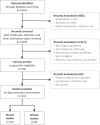Milk feed osmolality and adverse events in newborn infants and animals: a systematic review
- PMID: 30523072
- PMCID: PMC6764252
- DOI: 10.1136/archdischild-2018-315946
Milk feed osmolality and adverse events in newborn infants and animals: a systematic review
Abstract
Background: High feed osmolality (or osmolarity) is often suggested to be linked with adverse gastrointestinal events in preterm infants.
Aim: To systematically review the literature on milk feed osmolality and adverse gastrointestinal events in newborn and low birthweight infants and animals.
Methods: MEDLINE, Embase, CAB Abstracts, Current Contents, BIOSIS Previews and SciSearch were searched from inception to May 2018 to identify potentially relevant studies.
Inclusion criteria: randomised controlled or observational studies of newborn and low birthweight infants or animals investigating the effects of milk-based feeds with different osmolalities. Only full-text, English-language papers were included.
Results: Ten human and six animal studies met the inclusion criteria. Of human studies, seven reported no differences in adverse events with varying feed osmolalities; one reported delayed gastric emptying with feed osmolarity of 539 mOsm/L compared with lower levels; one reported higher necrotising enterocolitis (NEC) incidence with feed osmolarity of 650 mOsm/L compared with 359 mOsm/L; one found higher NEC incidence with the lowest feed osmolality (326 mOsm/kg compared with 385 mOsm/kg). Of animal studies, two reported delayed gastric emptying with feed osmolarity >624 mOsm/L, one reported decreased survival due to dehydration with dietary osmolarities ≥765 mOsmol/L and none reported increased NEC incidence with differing feed osmolalities. No clear mechanisms were found, and diet composition differences limited the interpretations regarding the independent impact of osmolality.
Conclusions: There is no consistent evidence that differences in feed osmolality in the range 300-500 mOsm/kg are associated with adverse gastrointestinal symptoms in neonates.
Keywords: infant feeding; neonatology; nutrition; osmolality; tolerance.
© Author(s) (or their employer(s)) 2019. Re-use permitted under CC BY-NC. No commercial re-use. See rights and permissions. Published by BMJ.
Conflict of interest statement
Competing interests: Z-ME, HSGT and RMvE are employees of Danone Nutricia Research, Utrecht, The Netherlands. NDE has previously conducted research with support from manufacturers of infant formula including Nestec SA (Switzerland), Wyeth UK and Nutricia UK but did not receive any payment, support or benefit in kind for contribution to this manuscript and has no ongoing personal, consultancy or financial relationships with Nutricia or other relevant commercial interest. PTS has nothing to declare.
Figures



References
Publication types
MeSH terms
LinkOut - more resources
Full Text Sources
Medical
Miscellaneous
